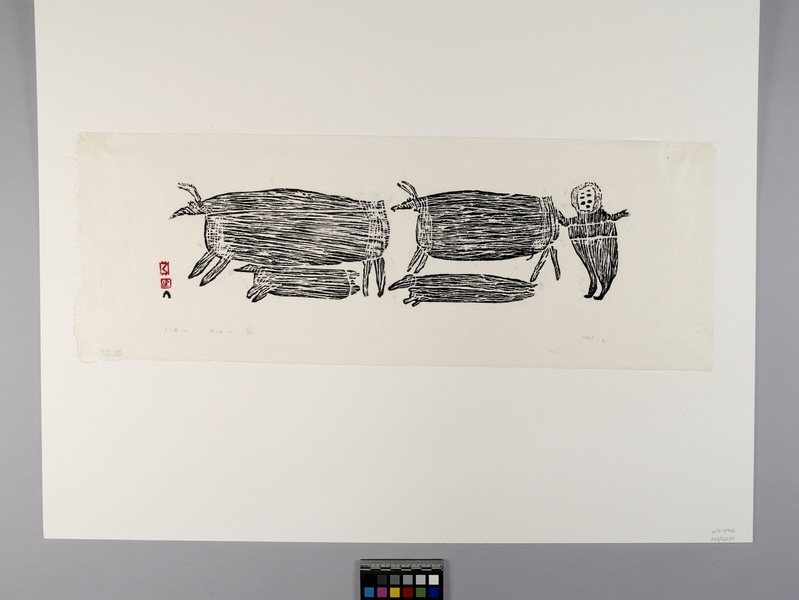Man and Caribou Item Number: Na1546 from the MOA: University of British Columbia

Description
Two square shaped caribou with horns. Man on the right of the animals. The smaller animals under the caribou. The bodies have horizontal line markings. Bottom stamped with names of artist and printmaker in Inuit syllabics in monogram form with Cape Dorset stylized igloo in left corner. Canadian Eskimo Arts Council stamp of approval and Cape Dorset stamp blind embossed in lower right corner.
History Of Use
The Inuit prints consist of stencils, stonecut engravings and lithographs from the communities of Cape Dorset, Baker Lake, Povunenituk, Holman Island, Pangnirtung and Clyde River. The first Cape Dorset prints were in 1959, Povunenituk in 1962, Holman in 1965, Baker Lake in 1970, Pangnirtung in 1973 and Clyde River in 1981. Since the late 1940's Indian and Northern Affairs have supported the development of art from the Canadian Arctic in co-operation with the Canadian Eskimo Arts Council. Catalogues have been published since 1959 and most of the prints are documented in their year of production. A print shop was set up by James Houston in Cape Dorset in 1958. Stonecutters Igola, Eegvudluk, Luktlak and Kanangenak began training for printmaking. James Houston decided that the co-operative would work well in the Inuit community. Specialists would prepare and cut the stone block, another artist would do the drawing and someone else would do the printing. The symbol used by the Cape Dorset group was a stylized igloo. The Cape Dorset Co-operative produces an annual catalogue illustrating and documenting prints produced within that year.
Narrative
Balshine family collection.
Item History
- Made by Parr (Maker) in Cape Dorset, Nunavut, Canada and Kinngait, Nunavut, Canada during 1962
- Owned by Lorne Balshine before January 25, 1988
- Received from Lorne Balshine (Seller), Finning Ltd. (Funding source) and University Purchase (Funding source) on January 25, 1988
What
Who
- Culture
- Inuit
- Creator
- Parr (Maker)
- Previous Owner
- Lorne Balshine
- Received from
- Lorne Balshine (Seller), Finning Ltd. (Funding source) and University Purchase (Funding source)
Where
- Holding Institution
- MOA: University of British Columbia
- Made in
- Cape Dorset, Nunavut, Canada and Kinngait, Nunavut, Canada
When
- Creation Date
- during 1962
- Ownership Date
- before January 25, 1988
- Acquisition Date
- on January 25, 1988
Other
- Item Classes
- works on paper
- Condition
- good
- Accession Number
- 1263/0368